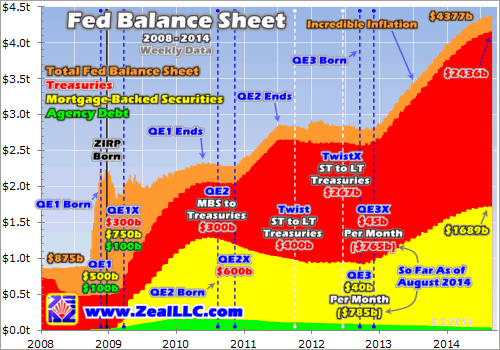 The Federal Reserve’s third quantitative-easing campaign is on track to wind down in late October. At that point the Fed will likely stop printing new money to buy bonds, a sea-change shift with ominous implications for the stock markets. Their entire surreal levitation during QE3 mirrored the huge growth in the Fed’s balance sheet from QE3′s bond monetizations. When they cease, another major selloff is likely.
The Federal Reserve’s third quantitative-easing campaign is on track to wind down in late October. At that point the Fed will likely stop printing new money to buy bonds, a sea-change shift with ominous implications for the stock markets. Their entire surreal levitation during QE3 mirrored the huge growth in the Fed’s balance sheet from QE3′s bond monetizations. When they cease, another major selloff is likely.
QE3′s impact on the global financial markets has been vast beyond belief. The Fed launched QE3 in September 2012, just before the important United States elections. This goosed the US stock markets in that critical final couple months ahead of the elections, right when they were on the verge of selling off dramatically. Odds are very high that the Fed’s brazen market manipulation gave the election to Obama.
In the 28 presidential elections since 1900 prior to that 2012 one, the stock markets rallied in September and October 16 times. The incumbent party won 15 of those elections! And during the 12 times when the stock markets fell in September and October, the incumbent party lost 10. The Fed choosing to launch a stock-market-boosting QE campaign in those pre-election months forced stock markets higher.
If the S&P 500 (SPX) had dropped as it was set to do in September and October 2012, Obama would’ve almost certainly been a one-term president. The Fed’s colossal market and political manipulation was no accident. Since QE2, Republican lawmakers had been highly critical of the Fed’s money printing to buy bonds. The low interest rates that spawned enabled Obama’s record debt-fueled spending binge.
Since the Fed faced serious challenges to its independence all the way up to its very existence from a Republican president and Congress, it massively intervened in the markets to sway an election. And QE3 just got worse from there. The Fed expanded it to include direct monetizations of US Treasuries a few months later in December 2012. That forced rates lower, farther fueling Obama’s epic deficit spending.
QE3 was far different from QE1 and QE2, which were finite from their births. QE3 was the Fed’s first open-endeddebt-monetization campaign, with no prescribed limits. This potentially unlimited scope of QE3 helped create an exceedingly unfortunate side effect in the stock markets. Since QE3 had no defined end, stock traders figured it would be around to backstop stock markets more or less indefinitely.
Led by uber-inflationist Ben Bernanke, the Fed’s dovish communications fanned this popular belief among traders. Over and over during QE3 the Fed implied that it was ready to act, in effect to increase the scale of QE3′s monthly money printing to buy bonds, if the stock markets slid. This incessant Fed jawboning left stock traders utterly fearless, as they figured the Fed would arrest any major stock-market selloff.
So every dip was quickly bought, leading to the stock markets soaring. The SPX blasted 29.6% higher in 2013, the only full year of QE3! And this flagship index is up 39.5% since QE3′s birth. And it wasn’t like the stock markets were low before the Fed hatched its QE3 scheme. As of the day before, the SPX had powered 112.3% higher over 42 months in a very large cyclical bull. Stock markets were already lofty.
This post was published at ZEAL LLC on September 5, 2014.

 Follow on Twitter
Follow on Twitter
Recent Comments